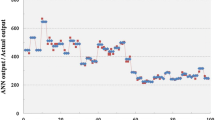Abstract
Power grip and pinch force are considered as important parameters of hand function. The aims of the present study were to compare the maximum hands strength of Taiwanese workers with the results from different countries and to establish the prediction models on the maximum muscle strength for different type of force exertion for Taiwan manufacturing workers.
One hundred and ninety-eight participants (99 males/99 females) were recruited to measure three different types of maximum strength (power grip, palmar pinch, lateral pinch). The participants were in five different groups (20–24, 25–34, 35–44, 45–54, 55–64).
Study results revealed that hand strength of power grip, lateral pinch and palmar pinch of right-hand exertion were 31.9 ± 12.6 kgw, 7.1 ± 2.2 kgw and 6.6 ± 2.0 kgw, respectively. Most of the maximum hands strengths of Taiwanese workers were smaller than those in Europeans and American. Using power grip force predict lateral pinch (Adjusted R2 = 0.717) and palmar pinch (Adjusted R2 = 0.609).
Access this chapter
Tax calculation will be finalised at checkout
Purchases are for personal use only
Similar content being viewed by others
References
Nilsen, T., Hermann, M., Eriksen, C.S., Dagfinrud, H., Mowinckel, P., Kjeken, I.: Grip force and pinch grip in an adult population: reference values and factors associated with grip force. Scand. J. Occup. Ther. 19(3), 288–296 (2012)
Massy-Westropp, N., Health, M., Rankin, W., Ahern, M., Krishnan, J., Hearn, T.C.: Measuring grip strength in normal adults: reference ranges and a comparison of electronic and hydraulic instruments. J. Hand Surg.-Am. 29A(3), 514–519 (2004)
Mathiowetz, V., Weber, K., Volland, G., Kashman, N.: Reliability and validity of grip and pinch strength evaluations. J. Hand Surg.-Am. 9A(2), 222–226 (1984)
Mathiowetz, V., Kashman, N., Volland, G., Weber, K., Dowe, M., Rogers, S.: Grip and pinch strength - normative data for adults. Arch. Phys. Med. Rehabil. 66(2), 69–74 (1985)
Innes, E.: Handgrip strength testing: a review of the literature. Aust. Occup. Ther. J. 46(3), 120–140 (1999)
Werle, S., Goldhahn, J., Drerup, S., Simmen, B.R., Sprott, H., Herren, D.: Age-and gender-specific normative data of grip and pinch strength in a healthy adult Swiss population. J. Hand Surg. (Eur. Vol.) 34(1), 76–84 (2009)
Chang, S.-Y.: Grip and key pinch strength: norms for 7 to 22 years-old students in Taiwan. TZU CHI Med. J. 14(4), 241–252 (2002)
Shih, Y., Fu, S., Wang, M.: The effect of hand posture on grip, pinch and torque exertions capabilities of hand. J. Occup. Saf. Health 4(1), 43–57 (1996)
Chaffin, D.B.: Ergonomics guide for the assessment of human static strength. Am. Ind. Hyg. Assoc. J. 36(7), 505–511 (1975)
Han, S.-H., Nam, K.-S., Ahn, T.-K., Dan, J.-M.: Analysis of grip and pinch strength in Korean people. J. Korean Orthop. Assoc. 44(2), 219–225 (2009)
Mohammadian, M., Choobineh, A., Haghdoost, A.A., Nejad, N.H.: Investigation of grip and pinch strengths in Iranian adults and their correlated anthropometric and demographic factors. Work 53(2), 429–437 (2016)
Steiber, N.: Strong or weak handgrip? Normative reference values for the German population across the life course stratified by sex, age, and body height. PLoS One 11(10), 14 (2016)
Shih, Y.-C.: Effect of a splint on measures of sustained grip exertion under different forearm and wrist postures. Appl. Ergon. 36(3), 293–299 (2005)
Harth, A., Vetter, W.: Grip and pinch strength among selected adult occupational groups. Occup. Ther. Int. J. 1(1), 13–28 (1994)
Gunther, C.M., Burger, A., Rickert, M., Crispin, A., Schulz, C.U.: Grip strength in healthy Caucasian adults, reference values. J. Hand Surg.-Am. 33A(4), 558–565 (2008)
Acknowledgements
Part of this study was a research grants supported by the Ministry of Science and Technology, Taiwan (MOST 107-2221-E-039-009-MY2).
Author information
Authors and Affiliations
Corresponding author
Editor information
Editors and Affiliations
Rights and permissions
Copyright information
© 2020 Springer Nature Switzerland AG
About this paper
Cite this paper
Chao, SM., Chiu, YC., Lo, EW. (2020). The Prediction Models of the Maximum Power Grip Strength and Pinch Strength in Taiwan Manufacturing Workers. In: Goossens, R., Murata, A. (eds) Advances in Social and Occupational Ergonomics. AHFE 2019. Advances in Intelligent Systems and Computing, vol 970. Springer, Cham. https://doi.org/10.1007/978-3-030-20145-6_46
Download citation
DOI: https://doi.org/10.1007/978-3-030-20145-6_46
Published:
Publisher Name: Springer, Cham
Print ISBN: 978-3-030-20144-9
Online ISBN: 978-3-030-20145-6
eBook Packages: EngineeringEngineering (R0)



